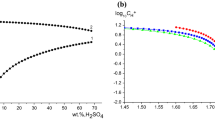Abstract
Nearly four decades ago, we published a simple chemical regularity: the proton affinity of MHa is higher than that of MHb when “a” is greater than “b.” Some new thoughts about this pattern of chemical energetics are presented in the current study.
Similar content being viewed by others
References
Greenberg A, Winkler R, Smith BL, Liebman JF (1982) The negatively charged nitrogen in ammonium ion and derived concepts of acidity, basicity, proton affinity, and ion energetics. J Chem Educ 59:367–370
Crabtree KN, Talipov MR, Martinez Jr O, O'Connor GD, Khursan SL, McCarthy MC (2013) Detection and structure of HOON. Microwave spectroscopy reveals an O-O bond exceeding 1.9 Å. Science 342(6164):1354–1357 Acknowledging JFL’s “parental” pride, like Barbara L Smith, Oscar Martinez had also been his undergraduate student. In Martinez’ case, besides classroom experience, he additionally did research with JFL on altogether different species than HOON and related small molecules
DeKock RL, Barbachyn MR (1979) Proton affinity, ionization energy, and the nature of frontier orbital electron density. J Am Chem Soc 101:6516–6519
Allen LC (1989) Electronegativity is the average one-electron energy of the valence-shell electrons in ground-state free atoms. J Am Chem Soc 111:9003–9014
Rahm M, Zeng T, Hoffmann R (2019) Electronegativity seen as the ground-state average valence electron binding energy. J Am Chem Soc 141:342–351
Aue DH, Webb HM, Bowers MT (1975) Proton affinities, ionization potentials, and hydrogen affinities of nitrogen and oxygen bases. Hybridization effects. J Am Chem Soc 97:4137–4139
Bent HA (1960) Distribution of atomic s character in molecules and its chemical implication. J Chem Educ 37:616–624
Bent HA (1961) An appraisal of valence-bond structures and hybridization in compounds of the first-row elements. Chem Rev 61:275–311
Pomerantz M, Liebman JF (1975) Is 100% s-character necessary? Tetrahedron Lett:2385–2388
Garcia GA, Gans B, Tang X, Ward M, Batut S, Nahon L, Fittschen C, Loison J-C (2015) Threshold photoelectron spectroscopy of the imidogen radical. J Electron Spectrosc Relat Phenom 203:25–30
Moore CE (1970) “Ionization potentials and ionization limits derived from the analyses of optical spectra” Nat Stand Ref Data Ser - Nat Bur Stand (U.S.), NSRDS-NBS 34
Liebman JF (1972) Why is the oxygen in water negative? J Chem Educ 49:415–417
Author information
Authors and Affiliations
Corresponding authors
Additional information
Publisher’s note
Springer Nature remains neutral with regard to jurisdictional claims in published maps and institutional affiliations.
Rights and permissions
About this article
Cite this article
Greenberg, A., Liebman, J.F. Paradigms and paradoxes: revisiting the relation of oxidation state and acidity of polyhydride cations. Struct Chem 30, 1629–1630 (2019). https://doi.org/10.1007/s11224-019-01402-0
Received:
Accepted:
Published:
Issue Date:
DOI: https://doi.org/10.1007/s11224-019-01402-0




